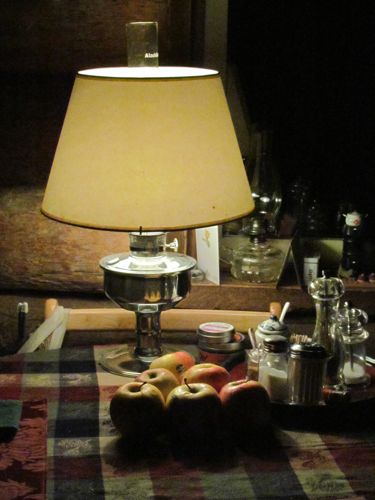Years ago, when I became interested in oil lamps (see Oil Lamps as Alternative Lighting in the Home) I read about Aladdin lamps. I’d occasionally seen them in family and friends’ homes growing up, but avoided them because they use mantles to create light.
I come from a camping family. The tungsten-bright light of the old pump Coleman lanterns had illuminated many evenings in my childhood. One afternoon, on a family campout, I found the camp’s Coleman unlit and unattended. Curious, I opened the lantern and gently touched the mantle. It broke, crumbling so easily, I had the impression the fine mesh had been nothing more than ash.
I was ashamed of myself for breaking the mantle. Later, when I learned how expensive they were, I felt even worse. I’ve kind of made a point of avoiding mantle lanterns ever since.
The Aladdin Company developed the mantle refinement to the oil lamp at the beginning of the previous century. Victor Samuel Johnson, a Nebraska farm boy, invented it. It remains the brightest, most efficient oil lamp available today.
Months ago, I found a pedestal Aladdin with a parchment shade at Talia’s Treasures, our town’s private secondhand store (see Museum of Lost Desires). The complete lamp’s price in the shop was lower than the cost of one of the mantles to service it. I thought about it for a long time, and finally decided to purchase it.
We now have it on our dining table. Even though the quickly returning daylight heralds the end of our oil lamp use for the season, it comes in handy in the evening. The LED light fixture above the table causes incredible interference when we listen to the evening news on the radio, so even on nights when we have plenty of power, we tend to leave the electric light off.
Buying this lamp broke my rule against solid body lamps. The aluminum reservoir doesn’t show fuel level; I have to pick it up and shake it to see how much oil remains. At least the reservoir is large, so we don’t have to refill it as often as smaller lamps.
Lighting and maintaining an Aladdin requires more work than a simple oil lamp. It also pours heat out the top—around 2800 BTUs according to the company. Our low ceiling barely clears the heat column! But, we can read by it much more easily than our other oil lamps
We found parts of an Aladdin lamp when we moved to the “homestead.” It took me a long time to identify it for what it was. I told Aly in a recent letter that the glass bowl of the lamp had shattered, but I just found it whole the other day. I’m thinking of restoring it, although it’ll take some work to clean up the brass mechanism, and a bigger investment to replace the chimney and mantle than the table model had been. But, if I order replacement parts to keep the new lamp going, many of the parts are interchangeable, and will serve both lamps.


I’m surprised your LED lights cause noticeable interference with the radio.
I’m assuming the power feed to the LED lights is 12V DC?
Have you tried running this feed a couple of time through a ferrite bead? This should reduce radio interference. You can buy clip-on ferrite beads you run the cable through or ‘ring’ beads you wrap the cable around.
[Something like this: http://palomar-engineers.com/wp-content/uploads/20131222_125533.jpg%5D
Skvez, this is the first I’ve heard of these, although now that I’ve read up on them, I see that we have a lot of them on various cords around the house. I’ll check at our local Radio Shack to see if they have any of the snap on ferrite cores that the company makes. Thanks for the tip!
It’s odd–I’ve researched solutions to this interference problem, and read a lot of fairly complicated procedures, but none of them have mentioned these beads. Seems like a really cheap, simple solution that a lot of people have bypassed in favor of more difficult methods.